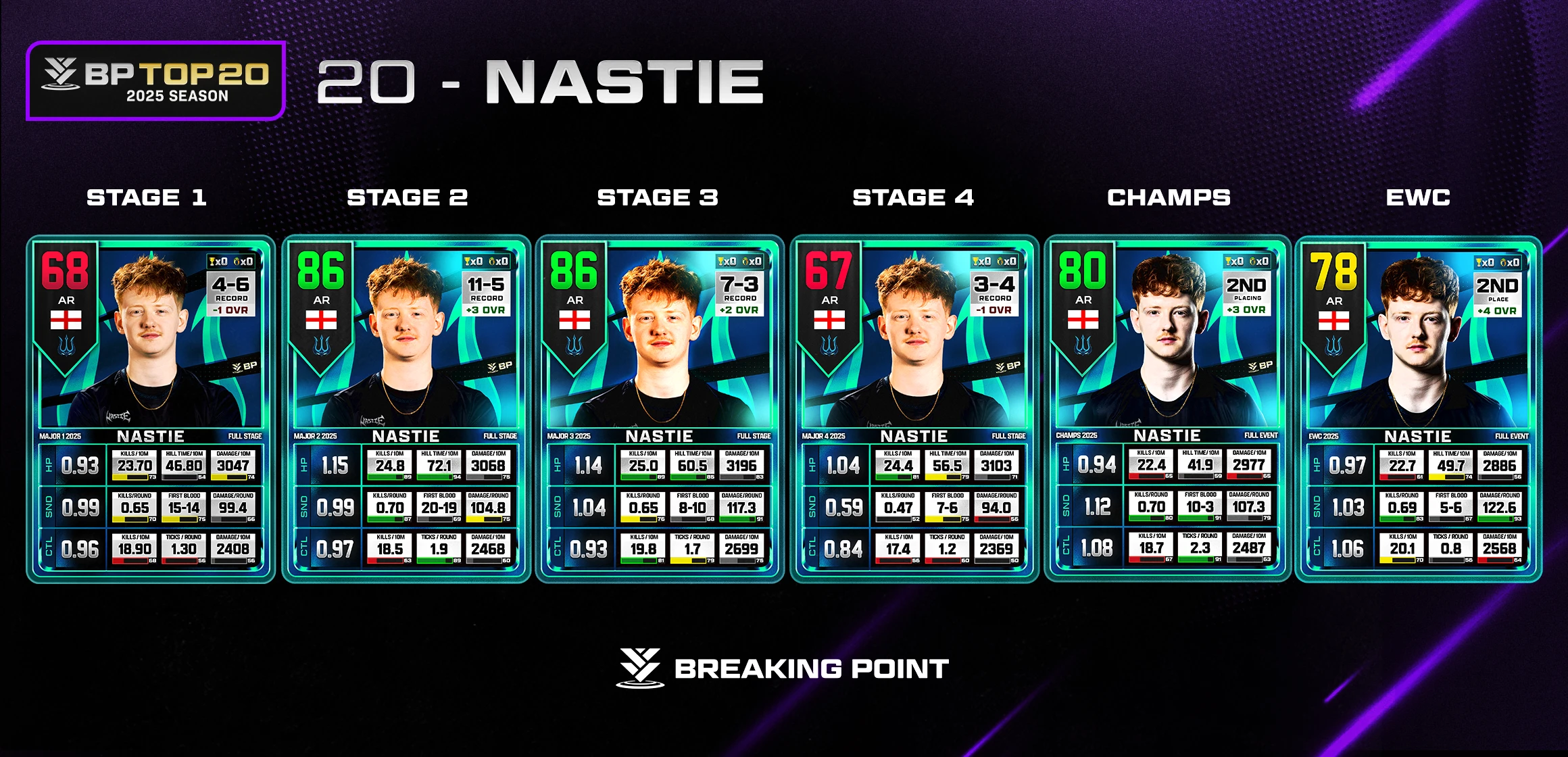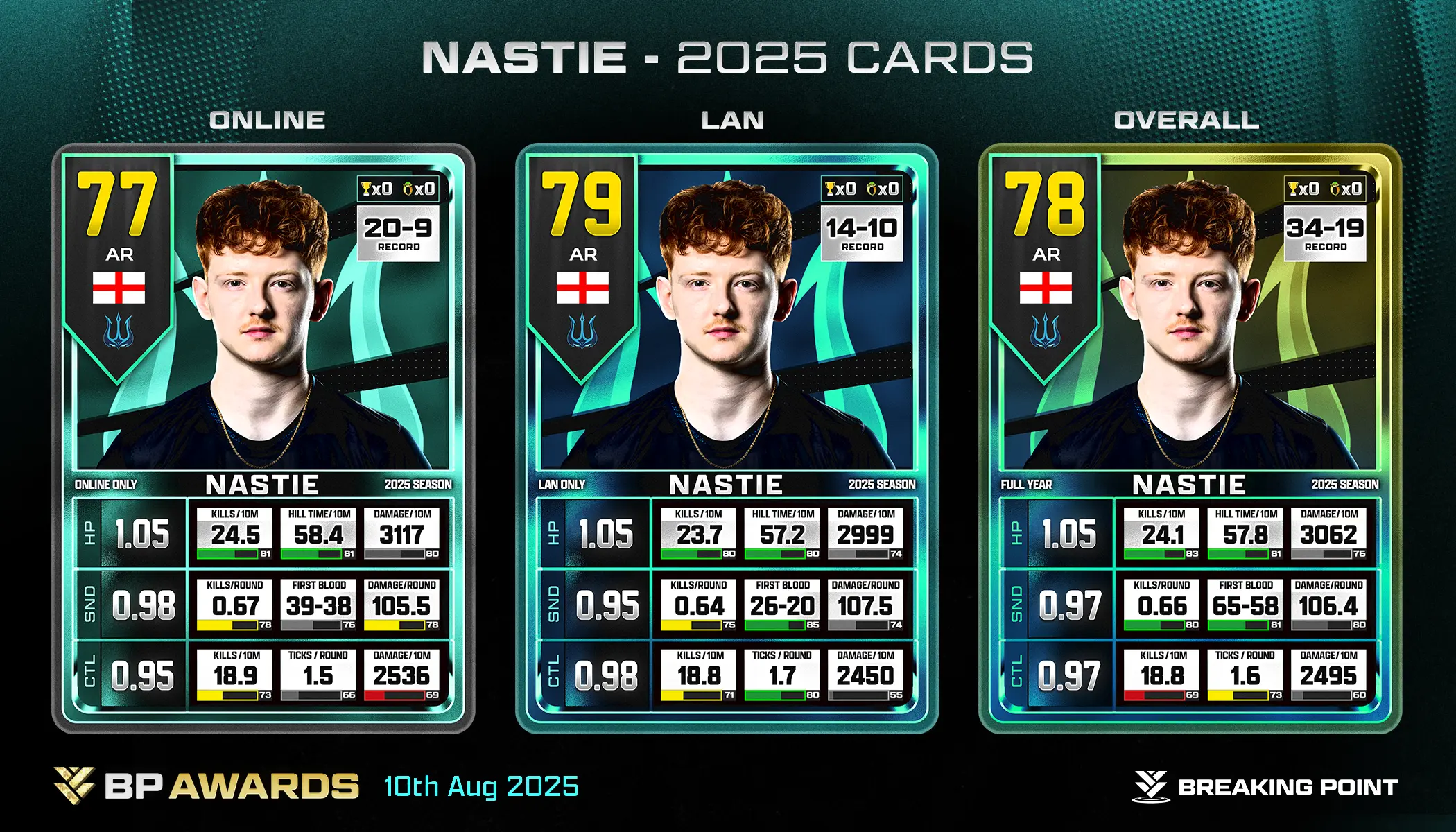#20 Nastie: Top 20 Players of Black Ops 6
The #20 Player of the Black Ops 6 season is the English Ginga Ninja, Byron “Nastie” Plumridge of the Vancouver Surge.
-1754545169518.webp)
Joining the Canadian Franchise at the start of the season, Nastie was hoping to build upon the Grand Finals appearance in the Esports World Cup in 2024 with the LA Thieves. The Englishmen did more than just that, helping the Surge make the Grand Finals of four of the six LANs. On the backline with his AR Duo Jordan “Abuzah” François, he finished with a 1.01 overall K/D on the year, reaching a high of 1.08 in Stage 2. In a year where only four teams made the Grand Finals of a LAN, it was a major feat for the Vancouver squad to consistently find themselves in that position.
Season Review

The 2024 Modern Warfare 3 season saw Nastie compete with the LA Thieves at the end of the season after starting the year with Team WaR in the European Challengers Circuit. After joining the Thieves in Stage 2, he’d end the year with a 4th place finish at Champs and 2nd at the inaugural Esports World Cup. This propelled Nastie’s stock, making him a prime target in the offseason heading into Treyarch’s Black Ops 6.
With sophomores Abuzah & Jovan “O4” Rodriguez already signed to the Surge, the franchise had a solid core that could attract top-tier talent. Signing Nastie with fellow Englishman Charlie “Hicksy” Hicks created a team that had high slaying potential with solid fundamental players.
Going into the season, they were projected to be a team fighting to be in the upper half of the League. With the bigger names of OpTic Texas, LA Thieves, and Atlanta FaZe projected to be the Big 3, it left the door open for teams to compete for the fourth spot.
-1754545169518.webp)
📸 Photo by @CODLeague
The first Stage of the season would be a rollercoaster for the Surge. They’d start 1-3 in the opening qualifiers, then finish last in the first Minor of the Season. The squad would rebound in the qualifiers to finish 4-3 going into the Major, giving hope that they could be clicking heading into Toronto. Sadly, it wouldn’t be the case, as the team would drop back-to-back matches to be eliminated Top 12. The non-competitive losses to both Toronto Ultra & Minnesota Rokkr proved to be the final nail in the coffin, leading to the acquisition of Travis “Neptune” McCloud in place of Hicksy.
The new roster achieved the high potential the original core had deep within, being unlocked by the high-paced Neptune. Going 5-2 in the second qualifiers, the team also found success in the final Minor of the year. Vancouver would take down Boston Breach, Atlanta FaZe, and Toronto Ultra en route to reaching the Grand Finals.
While they fell short against the Thieves, the momentum carried over to the Major. Nastie & Co. Would go on a run, taking down Carolina & Boston to set up a dance with Atlanta in the Winner’s Final. Even though the Surge fell 2-3, they’d make it into the Grand Finals by beating Toronto to secure a top 2 finish. It’d be the Surge’s first test of Finals experience, but the 0-4 loss in the Finals to FaZe would sting & be a prelude to the future of the squad.
-1754545169518.webp)
📸 Photo by @SurgeVancouver
Now off two Finals appearances in Stage II, the Surge were poised to take another step in the second half of the season. Now known as a threat in the League, Vancouver continued their excellent form with a 4-1 record in the third qualifier. With 40 CDL Points in the bag, the Surge locked in the 3rd seed heading to Boca Raton for Major III.
Behind a major 3-2 upset over FaZe in Winner’s Round 1, Nastie & the Surge found themselves again in the Winner’s Final. They’d be unable to overcome the Thieves yet again, falling in both the Winner’s Finals and then 0-4 in the Grand Finals. While the team was building, going 0-8 in map count put a serious dent in the team’s momentum going into the final portion of the year.
After two heartbreaking defeats, the team was primed for a letdown during Stage IV of the season. Even though they finished with a 3-2 record in the qualifiers, Surge fell to both Atlanta & Texas. The Major would only bring more pain to the squad, as with back-to-back losses to LA Thieves & Vegas Falcons would see the team be eliminated Top 12 and exit the tournament very early. While the letdown was harsh, with 330 CDL Points, the Surge locked in the 4th Seed for Champs & set up a showdown with the Miami Heretics in Round 1.
-1754545169518.webp)
📸 Photo by @syrupfx
Champ would begin with a distressing loss to the Spanish side, losing 1-3 to the Heretics. The loss would drop them into the Elimination Bracket, but not eliminate them. Behind Nastie, the team would take down LA, Toronto, Miami, and Boston on their path to the Grand Finals. While they swept the Thieves & Ultra, the squad was tested with Game 5 thrillers against both the Heretics & Breach. While they had an impressive run, OpTic would shut them down in the Grand Finals, relegating the Surge to another 2nd place finish, but this time with a $480,000 prize.
The Final tournament of the year would take place in Riyadh, as the Esports World Cup saw 16 teams compete for the $1,800,000 prize pool. Vancouver would look to break the 2nd-place curse, and came into the LAN with a fire lit under them. The team would go flawless in pool play, beating Team Orchid 3-1 and 100 Thieves 3-2. In the single-elimination bracket, Surge would march through both FiveFears (3-0 win) and KOI (3-2 win). While it looked like it might be time for the Surge to break through, OpTic had other plans. It’d end up being another crushing defeat, with OpTic taking the Championship 4-0.
While the Surge never got to lift a trophy, they performed overwhelmingly better than their original season expectations. Making four Grand Finals on LAN and one in a Minor is a hallmark of a great team, even if they weren’t able to seal the deal.
How Good Was Nasite in 2025?

Hardpoint
Nastie was a consistent slaying force for the Surge in Hardpoint, ending the year with a 1.05 K/D in the mode this season. He stayed consistent whether online or on LAN, ending with a 1.05 K/D on both. When Nasite played well in Hardpoint & finished with a positive K/D, Vancouver went 42-10 for an 80.8% win rate. The Englishman had multiple standout performances on the year, going off for a 2.29 K/D in a Skyline Hardpoint vs Carolina, the 3rd highest K/D in an Online Hardpoint. When facing Boston on Hacienca, Nastie finished with 161 seconds of Hill Time, 5th most in a LAN map this season. While his slaying statistics don’t jump off the page, he was instrumental in Surge’s success in the mode.
Vancouver’s best mode of the season was Hardpoint, finishing with a 56-35 record on the season, ranking 2nd in the CDL. They had the 3rd best average margin (+19.4), 2nd best hold rate (76.8%), and 3rd best break rate (31.7%). The team remained very consistent, like Nastie, both on LAN and online. Surge would go 25-16 on LAN, good for a 61% win rate compared to a 62% win rate in online matches. These numbers skyrocket when taking out Stage 1 with Hicksy, going 50-26 in the mode with Neptune, ranking 1st in the League. With Neptune, they were the #1 in both Holding (79.7%) and Breaking (34%), behind a modest 1.04 team K/D. With Rambo as their coach, fundamentals were key to their success.
SND
While it wasn’t his strongest mode, Nastie was able to play efficiently in Search & Destroy. The Main AR ended with a 0.97 K/D in the mode with 0.66 kills per round, an ADR of 106.4, and won 52.8% of his opening duels. During the Finals of Minor II, Nastie put up the 5th most damage in an online SND map this season (1,953). While there were the ups & downs of the season, Byron showed up when it mattered most. At Champs, Nastie had a 1.12 K/D in the mode with improved numbers in kills per round (0.70), ADR (107.3), and OpD Win Percentage (77%) to go with 2 clutches. The value of Nastie came with his consistency, high floor, and bringing the best out of his teammates.
-1754545169518.webp)
📸 Photo by @CODLeague
The weakest mode for the Surge? Search & Destroy. The Surge ranked 9th in the CDL with a 36-40 record on the season, including 15-19 on LAN. While their record was lackluster, the team did have serious ice in Game 5s. Going 12-7 on the year, the team ranked 3rd in the League and won 5-stright to end the season. The final portion of the season saw their form disappear, going 11-15 (9th in the CDL) during Stage IV, Champs, & EWC. They struggled in opening duels, winning just 45% (11th) and converting 66% (11th). While their respawn was solid, their SND left some to be desired.
Control
Sadly, Control was the weakest of the modes for the Red Thunder. Ending with a 0.97 K/D in the mode for the year, he ranked below average in kills per 10 minutes (18.8), damage per 10 minutes (2495), and ticks per attacking round (1.6). While the numbers slightly improved on LAN, they remained static. In the two biggest tournaments of the year, Nastie did step up. Ending with a 1.06 K/D in EWC and 1.08 K/D in Champs, he ended the year on the right path heading into BO7.
While the Surge roster was one of the best Hardpoint teams, that didn’t always translate over to the second respawn mode, Control. With a 29-26 record in the mode, they ranked 5th in the CDL, but were 8-2 in their last 10 matches on the season. Much like their Map 5 ice, Vancouver led the League with a 10-3 record in Round 5s. With Nastie in the lineup, they were an above-average attacking team, capturing 3.6 ticks per attack (3rd), but struggled on the defensive side.
A look ahead to Black Ops 7
As rostermania shakes up the competitive Call of Duty landscape, Nastie’s future remains uncertain, with no clear indication yet of where the talented AR player will land for the Black Ops 7 season. Despite the lack of clarity, Nastie is expected to draw strong interest across the league after a solid year with the Vancouver Surge, showcasing versatility and composure in high-pressure moments. His experience, adaptability, and ability to slot into multiple team environments make him a valuable asset for any organization looking to build a competitive roster heading into the new title.